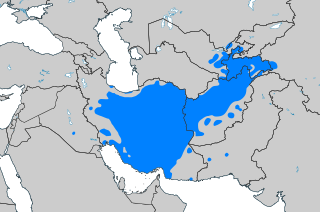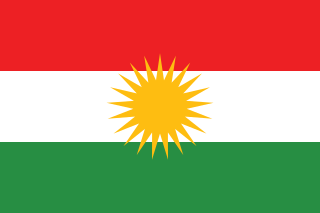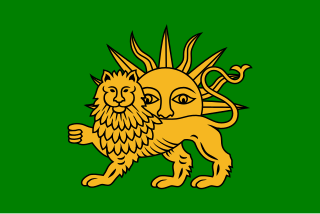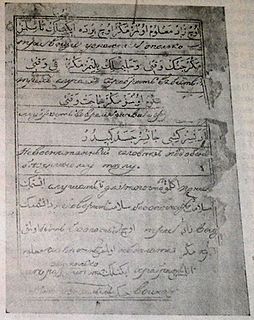
Persian, also known by its endonym Farsi, is a Western Iranian language belonging to the Iranian branch of the Indo-Iranian subdivision of the Indo-European languages. Persian is a pluricentric language predominantly spoken and used officially within Iran, Afghanistan and Tajikistan in three mutually intelligible standard varieties, namely Iranian Persian, Afghan Persian and Tajiki Persian. It is also spoken natively in the Tajik variety by a significant population within Uzbekistan, as well as within other regions with a Persianate history in the cultural sphere of Greater Iran. It is written officially within Iran and Afghanistan in the Persian alphabet, a derivation of the Arabic script, and within Tajikistan in the Tajik alphabet, a derivation of the Cyrillic script.

Kurds or Kurdish people are an Iranian ethnic group native to the mountainous region of Kurdistan in Western Asia, which spans southeastern Turkey, northwestern Iran, northern Iraq, and northern Syria. There are exclaves of Kurds in Central Anatolia, Khorasan, and the Caucasus, as well as significant Kurdish diaspora communities in the cities of western Turkey and Western Europe. The Kurdish population is estimated to be between 30 and 45 million.
The Persians are an Iranian ethnic group that make up over half the population of Iran. They share a common cultural system and are native speakers of the Persian language, as well as languages closely related to Persian.

The Kurdish languages constitute a dialect continuum, belonging to the Iranian language family, spoken by Kurds in the geo-cultural region of Kurdistan and the Kurdish diaspora. The three Kurdish languages are Northern Kurdish, Central Kurdish, and Southern Kurdish.

The Safavid dynasty was one of the most significant ruling dynasties of Iran from 1501 to 1736. The Safavid dynasty had its origin in the Safavid order of Sufism, which was established in the city of Ardabil in the Iranian Azerbaijan region. It was an Iranian dynasty of Kurdish origin, but during their rule they intermarried with Turkoman, Georgian, Circassian, and Pontic Greek dignitaries, nevertheless they were Turkish-speaking and Turkified. From their base in Ardabil, the Safavids established control over parts of Greater Iran and reasserted the Iranian identity of the region, thus becoming the first native dynasty since the Sasanian Empire to establish a national state officially known as Iran.

Azerbaijani or Azeri, also referred to as Azeri-Turkic or Azeri-Turkish, is a Turkic language from the Oghuz sub-branch spoken primarily by the Azerbaijani people, who live mainly in the Republic of Azerbaijan where the North Azerbaijani variety is spoken, and in the Azerbaijan region of Iran, where the South Azerbaijani variety is spoken. Although there is a very high degree of mutual intelligibility between both forms of Azerbaijani, there are significant differences in phonology, lexicon, morphology, syntax and sources of loanwords.

The Kurds, are an Iranian ethnic group in the Middle East. They have historically inhabited the mountainous areas to the south of Lake Van and Lake Urmia, a geographical area collectively referred to as Kurdistan. Most Kurds speak Northern Kurdish (Kurmanji) or Sorani, which both belong to the Kurdish languages.

Ismail I, also known as Shah Ismail I, was the founder of the Safavid dynasty of Iran, ruling as its King of Kings (shahanshah) from 1501 to 1524.

Azerbaijanis or Azeris, also known as Azerbaijani Turks, are a Turkic people living mainly in Northwestern Iran and in the sovereign Republic of Azerbaijan, with a mixed cultural heritage, including Caucasian, Iranian and Turkic elements. They are the second-most numerous ethnic group among the Turkic-speaking peoples after Turkish people and are predominantly Shia Muslims. They comprise the largest ethnic group in the Republic of Azerbaijan and the second-largest ethnic group in neighboring Iran and Georgia. They speak the Azerbaijani language, belonging to the Oghuz branch of the Turkic languages.

Luri is a Southwestern Iranian language continuum spoken by the Lur people, an Iranian people native to Western Asia. The Luri dialects are descended from Middle Persian and are Central Luri, Bakhtiari, and Southern Luri. This language is spoken mainly by the Bakhtiari and Southern Lurs in Iran.

Azerbaijani literature is written in Azerbaijani, a Turkic language, which is the official state language of the Republic of Azerbaijan, where the North Azerbaijani variety is spoken. It is also natively spoken in Iran, where the South Azerbaijani variety is used, and is particularly spoken in the northwestern historic region of Azerbaijan. Azerbaijani is also spoken natively in Russia, Georgia and Turkey. While the majority of Azerbaijani people live in Iran, modern Azerbaijani literature is overwhelmingly produced in the Republic of Azerbaijan, where the language has official status. Three scripts are used for writing the language: Azerbaijani Latin script in the Republic of Azerbaijan, Arabic script in Iran and Cyrillic script in Russia.

Azerbaijan or Azarbaijan, also known as Iranian Azerbaijan, is a historical region in northwestern Iran that borders Iraq, Turkey, the Nakhchivan Autonomous Republic, Armenia, and the Republic of Azerbaijan.

The Iranian languages or Iranic languages are a branch of the Indo-Iranian languages in the Indo-European language family that are spoken natively by the Iranian peoples.

The Erivan Khanate, also known as Chokhur-e Sa'd, was a khanate that was established in Afsharid Iran in the 18th century. It covered an area of roughly 19,500 km2, and corresponded to most of present-day central Armenia, the Iğdır Province and the Kars Province's Kağızman district in present-day Turkey and the Sharur and Sadarak districts of the Nakhchivan Autonomous Republic of present-day Azerbaijan.

New Persian, also known as Modern Persian and Dari (دری), is the final stage of the Persian language spoken since the 8th to 9th centuries until now in Greater Iran and surroundings. It is conventionally divided into three stages: Early New Persian, Classical Persian, and Contemporary Persian.
The Azerbaijani people are of mixed ethnic origins. These include the indigenous peoples of eastern Transcaucasia, the Medians, an ancient Iranian people, and the Oghuz Turkic tribes that began migrating to Azerbaijan in the 11th century AD. Modern Azerbaijanis are the second most numerous ethnic group among the Turkic peoples after Anatolian Turks and speak North Azerbaijani and/or South Azerbaijani. Both languages also have dialects, with 21 North Azerbaijani dialects and 11 South Azerbaijani dialects.
Iranian literature, or Iranic literature, refers to the literary traditions of the Iranian languages, developed predominantly in Iran and other regions in the Middle East and the Caucasus, eastern Asia Minor, and parts of western Central Asia and northwestern South Asia. These include works attested from as early as the 6th century BC. Modern Iranian literatures include Persian literature, Ossetian literature, Kurdish literature, Pashto literature, and Balochi literature, among others.
The majority of the population of Iran consists of Iranic peoples. The largest groups in this category include Persians and Kurds, with smaller communities including Gilakis, Mazandaranis, Lurs, Tats, Talysh, and Baloch.

Safavid Iran or Safavid Persia, also referred to as the Safavid Empire, was one of the greatest Iranian empires after the 7th-century Muslim conquest of Persia, ruled from 1501 to 1736 by the Safavid dynasty. It is often considered the beginning of modern Iranian history, as well as one of the gunpowder empires. The Safavid shahs established the Twelver school of Shia Islam as the official religion of the empire, marking one of the most important turning points in Muslim history.

West Azerbaijan Province is one of the 31 provinces of Iran. It is in the northwest of the country, bordered by Turkey, Iraq and Azerbaijan's Nakhchivan Autonomous Republic, as well as the provinces of East Azerbaijan, Zanjan and Kurdistan. The province is part of Region 3. It is separated from Armenia by Turkey's short border with the Azerbaijan Republic. The province of West Azerbaijan covers an area of 39,487 km², or 43,660 km² including Lake Urmia. As of the 2016 census, the province had a population of 3,265,219, in 935,956 households. The capital city and largest city of the province is Urmia.















